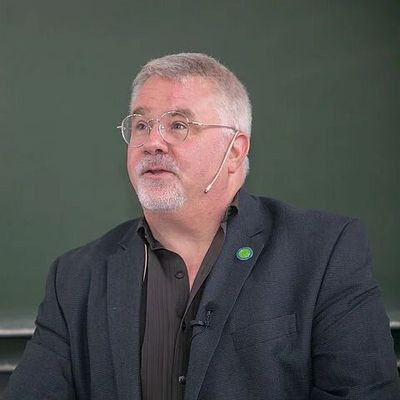Professor Dr. John C. Warner began studying music at the University of Massachusetts. The early death of a fellow band member led him to switch to chemistry and he would go on to develop an anti-cancer drug at Princeton University. As a researcher at Polaroid, he came into contact with Paul Anastas, a friend from his youth, who was now working for the Environmental Protection Agency (EPA). Together, they wrote the standard work “Green Chemistry: Theory and Practice”. As a professor at the University of Massachusetts he established the first doctoral program in green chemistry. He later married the program’s first female student Amy Cannon. With investor Jim Babcock, he founded the Warner-Babcock Institute for Green Chemistry and with his wife he established the educational organization “Beyond Benign". John Warner has been honorary professor at TU Berlin since 2021. Due to the restrictions arising from the coronavirus, it was only possible to officially award his certificate in September 2022.
Author: Wolfgang Richter, the interview was first published here.
Professor Warner, you are regarded as the founder of green chemistry. Despite this, you also maintain that chemical factories are part of nature. What exactly do you mean by this?
When termites in Australia build their bizarre dwellings using their spit, chewed leaves and soil, it is nothing other than applied chemistry. Conversely, everything we do is also part of nature. If we distance ourselves from nature, we cannot learn well from it.
And this is something we urgently need to do, because the substances in nature are usually far more harmless than those produced in factories.
I am talking now about a statistical average. Because there are also extremely toxic substances in nature. This is at the heart of what I am saying: Let's leave behind our prejudices of nature as good on the one hand and chemistry as evil on the other. It may be that a completely synthetic process has far fewer side effects than if I use a natural substance that I had to extract beforehand using a strong solvent.
OK, but why are natural substances on average more harmless?
Because every substance in nature has had to prove itself in countless life cycles over millions of years. A substance that has just emerged from a beaker in a laboratory has not gone through this selection process in terms of its compatibility with life. Modern chemistry has been around for about 250 years, natural cycles for 3.8 billion years. Guess who has the bigger textbook?
Cycles also play a big role in green chemistry.
On the one hand, yes. This is not just restricted to the recycling cycle that we are all familiar with, where the chemical composition remains the same and only the form changes, for example when I make bags out of plastic bottles. There is also a metabolism of materials, as I call it, where the form and composition change. For example, when biodegradable materials decompose. There are many such cycles and it is very instructive to study them. At the same time, we must always be aware that this is only part of the whole and our current state of knowledge. A cycle includes something - and always also excludes something.
That sounds very philosophical...
Green chemistry is philosophical; it requires humility, for example. We should never allow ourselves to be too certain. And we celebrate the physical principle of entropy, according to which it is more beneficial to have a variety of options rather than just one. Why should I choose between recycling or making sure my products are biodegradable? Why not recycle a biodegradable product?
On the other hand, green chemistry is extremely application-oriented. It is a collection of methods for chemists for developing less toxic compounds that can be produced in a safer and more environmentally friendly way, preferably from renewable resources, in the most energy-efficient way possible and producing as little waste as possible. This is still not taught as standard in chemistry courses today.
But it is here at TU Berlin, which was the first European institution ever to sign the Green Chemistry Commitment of your international organization "Beyond Benign". How do you support us in this as honorary professor?
Well, first of all of course I give lectures in master’s programs I also work closely together with the UniSysCat Cluster of Excellence, which develops new catalysts. Catalysts are essential to green chemistry, as they leave behind no waste products in the synthesis of substances. Finally, I am also active in an advisory capacity for the Chemical Invention Factory at TU Berlin. The focus here is on technology transfer from the lab to real life as well as how start-ups in the field of green chemistry can position themselves in the market.
You yourself are also an extremely successful entrepreneur...
Well, I can at least draw on and share my experiences of setting up six companies and establishing 350 patents. Many people think that applied chemistry is easier than conducting basic research. But the problems really explode here when a good idea comes up against the constraints of reality. And then you also have to convince investors that they are on to a good deal. Patents are very important here, because they provide security for investors. An important patent should actually achieve the same renown for a researcher as a publication in a first-class journal. This is the only way to strengthen the spirit of invention that we so badly need. In my estimation, 70 percent of all the technologies needed to solve our problems have not yet been invented.

